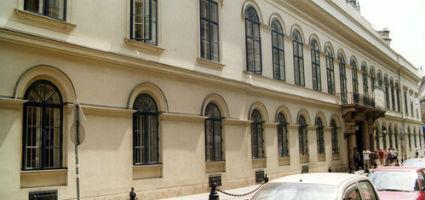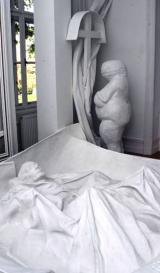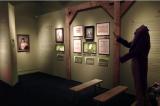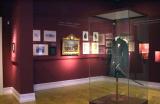2024. July 27. Saturday
Museum of Literature Petőfi - Budapest
 |
Address: 1053, Budapest Károlyi u. 16.
Phone number: (1) 317-3611
E-mail: muzeuminf@pim.hu
Opening hours: Tue-Sun 10-18
|
In 1954, a Council of Ministers order founded the Museum of Literature Petőfi with the aim of collecting and preserving records of Hungarian literature. The name of the Museum presented itself naturally, since the poesy of Sándor Petőfi, who died young in the 1848-49 War of Independence, symbolises Hungarian poetry to the general reader both within and beyond the borders of the country. With the establishment of the new, national institution, an important consideration was that the Museum should - as the legal successor of the Petőfi House, protector of the Petőfi legacy - continue and, at the same time, operate on a new basis.
Functioning as an exhibition and research centre from 1909 until 1945, Petőfi House was established partly with the intention of fostering the Petőfi cult, and partly as a consequence of the realisation that the authorial documents were not of collection interest to contemporary libraries, museums and archives at the end of the 19th century. The preservation launched by the Petőfi Society extended not only to the collection of Petőfi manuscripts, books and relics available at the time, but also to the purchasing of the Bajza Street house of Petőfi's fellow-writer, the extremely popular novelist, Mór Jókai. Jókai had lived there with his son-in-law, Árpád Feszty - thus the house also became the guardian and preserver of the Jókai records and cult. In 1945 the Petőfi House suffered bombardment, after which the Budapest History Museum was charged with the management of the collection. From the beginning of the 1950s onwards, in addition to Petőfi and Jókai, the Petőfi House also collected the documents of two outstanding figures of 20th-century Hungarian poetry: Attila József and Endre Ady. This resulted in the Petőfi House outgrowing its own limits and presented the need for the establishment of an independent literary museum.
The task of the new, national museum was not only to process and preserve the inherited collections under modern conditions, but also to collect materials of museum value from contemporary Hungarian literature. Acquisition is generally characterised by conscious, scholarly-founded, ideology-free expansion. Even today we work hard so that the writers' and poets' legacies, correspondence, libraries, sound and video recordings, photographs, furniture, personal belongings, etc., the documents of the editorial offices of literary periodicals and literary-type publishing houses - that is, the representatives of Hungarian literature both within and beyond the borders - should become part of our collection.
The present structure of the institution, specialised in the reception of complex authorial, literary legacies, professional processing, restoration and storage took shape in 1970. Besides the collection departments - the Manuscript Archive, the Library, the Art and Relics Collection and the Audiovisual Library - the newly created Public Relations Department and the Marketing Department organise the Museum's programmes.
The Museum's tasks have included the supervision of literary collections and exhibitions in areas outside Budapest ever since the institution was established. As a result, the Museum of Literature Petőfi has become an institution with nationwide authority in the field of Hungarian literary museology; it offers help with the organisation of exhibitions in memorial houses and memorial rooms in areas outside Budapest, and also remains in touch with memorial places abroad. Our Museum administrates the exhibitions and collections of our three provincial branches: the Kassák Museum, the Endre Ady Memorial Museum and the Jókai Memorial Room.
Since its establishment, the Museum of Literature has organised almost 500 exhibitions and issued more than 300 scholarly and popularising publications and exhibition catalogues. We hope that our work over the past fifty years has earned us a position in scientific life. We make use of the intellectual value of our collections, catalogues and databanks in critical editions, philological and textological research. Our museologists participate in university education as lecturers, and our volumes of essays and studies appear in the technical literature of cult research and literary museology.
Functioning as an exhibition and research centre from 1909 until 1945, Petőfi House was established partly with the intention of fostering the Petőfi cult, and partly as a consequence of the realisation that the authorial documents were not of collection interest to contemporary libraries, museums and archives at the end of the 19th century. The preservation launched by the Petőfi Society extended not only to the collection of Petőfi manuscripts, books and relics available at the time, but also to the purchasing of the Bajza Street house of Petőfi's fellow-writer, the extremely popular novelist, Mór Jókai. Jókai had lived there with his son-in-law, Árpád Feszty - thus the house also became the guardian and preserver of the Jókai records and cult. In 1945 the Petőfi House suffered bombardment, after which the Budapest History Museum was charged with the management of the collection. From the beginning of the 1950s onwards, in addition to Petőfi and Jókai, the Petőfi House also collected the documents of two outstanding figures of 20th-century Hungarian poetry: Attila József and Endre Ady. This resulted in the Petőfi House outgrowing its own limits and presented the need for the establishment of an independent literary museum.
The task of the new, national museum was not only to process and preserve the inherited collections under modern conditions, but also to collect materials of museum value from contemporary Hungarian literature. Acquisition is generally characterised by conscious, scholarly-founded, ideology-free expansion. Even today we work hard so that the writers' and poets' legacies, correspondence, libraries, sound and video recordings, photographs, furniture, personal belongings, etc., the documents of the editorial offices of literary periodicals and literary-type publishing houses - that is, the representatives of Hungarian literature both within and beyond the borders - should become part of our collection.
The present structure of the institution, specialised in the reception of complex authorial, literary legacies, professional processing, restoration and storage took shape in 1970. Besides the collection departments - the Manuscript Archive, the Library, the Art and Relics Collection and the Audiovisual Library - the newly created Public Relations Department and the Marketing Department organise the Museum's programmes.
The Museum's tasks have included the supervision of literary collections and exhibitions in areas outside Budapest ever since the institution was established. As a result, the Museum of Literature Petőfi has become an institution with nationwide authority in the field of Hungarian literary museology; it offers help with the organisation of exhibitions in memorial houses and memorial rooms in areas outside Budapest, and also remains in touch with memorial places abroad. Our Museum administrates the exhibitions and collections of our three provincial branches: the Kassák Museum, the Endre Ady Memorial Museum and the Jókai Memorial Room.
Since its establishment, the Museum of Literature has organised almost 500 exhibitions and issued more than 300 scholarly and popularising publications and exhibition catalogues. We hope that our work over the past fifty years has earned us a position in scientific life. We make use of the intellectual value of our collections, catalogues and databanks in critical editions, philological and textological research. Our museologists participate in university education as lecturers, and our volumes of essays and studies appear in the technical literature of cult research and literary museology.


